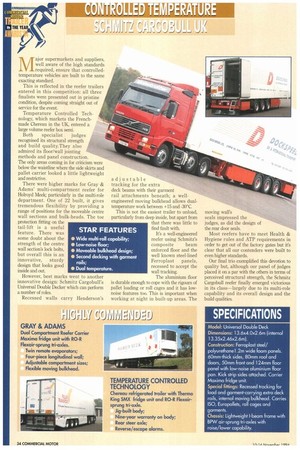..4.
Page 36

If you've noticed an error in this article please click here to report it so we can fix it.
.Major
aware of the high standards required, ensure that controlledtemperature vehicles are built to the same exacting standard.
This is reflected in the reefer trailers entered in this competition: all three finalists were presented out in pristine condition, despite coming straight out of service for the event.
Temperature Controlled Technology, which markets the Frenchmade Chereau in the UK, entered a large volume reefer box semi.
Both specialist judges recognised its structural strength and build quality.They also admired its floor/wall jointing methods and panel construction. The only areas coming in for criticism were below the waistline where the side skirts and pallet carrier looked a little lightweight and restrictive.
There were higher marks for Gray & Adams' multi-compartment reefer for Holroyd Meek; particularly in the multi-role department. One of 22 built, it gives tremendous flexibility by providing a range of positions for the moveable centre wall sections and bulk-heads. The toe protection fitting on the tail-lift is a useful feature. There was some doubt about the strength of the centre wall section's lock bolts, but overall this is an innovative, sturdy design that looks good inside and out.
However, best marks went to another innovative design: Schmitz Cargobull's Universal Double Decker which can perform a number of roles.
Recessed walls carry Henderson's • Wide multi-roll capability; • Low-noise floor; • Moveable bulkhead design; • Dual temperature. adjustable tracking for the extra deck beams with their garment rail attachments beneath; a wellengineered moving bulkhead allows dualtemperature work between +15 and -30°C.
This is not the easiest trailer to unload, particularly from deep inside, but apart from that there was little to find fault with.
It's a well-engineered reefer using Schmitz's composite beam enforced floor and the well known steel-lined Ferroplast panels, recessed to accept the wall tracking.
The aluminium floor is durable enough to cope with the rigours of pallet loading or roll cages and it has lownoise features too. This is important when working at night in built-up areas. The moving wall's seals impressed the judges, as did the design of the rear door seals.
Most reefers have to meet Health & Hygiene rules and ATP requirements in order to get out of the factory gates but it's clear that all our contenders were built to even higher standards.
Our final trio exemplified this devotion to quality but, although our panel of judges placed it on a par with the others in terms of perceived structural strength, the Schmitz Cargobull reefer finally emerged victorious in its class—largely due to its multi-role capability and its overall design and the build qualities.








































































































